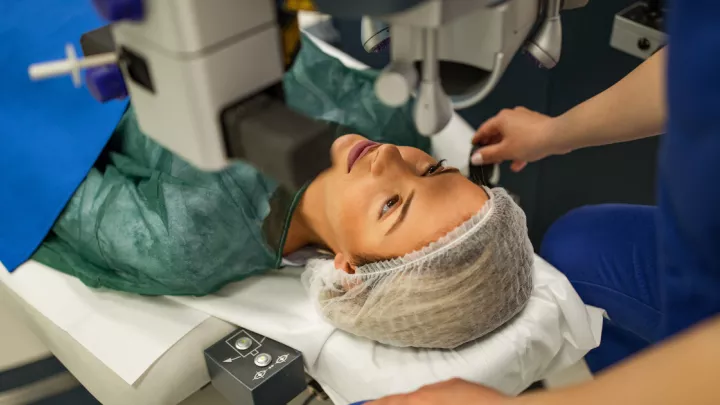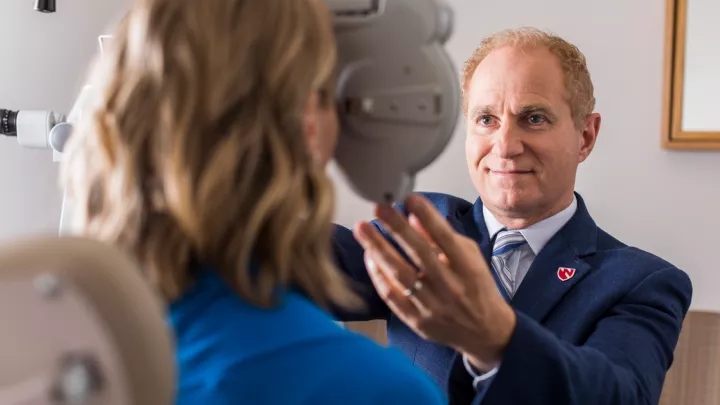EVO ICL: A reversible solution for vision correction

If you are looking to get rid of glasses or contact lenses, you may be looking for a new, entirely reversible solution in the form of an intraocular, vision-correcting implant.
EVO ICL®, or an Implantable Collamer Lens, is a refractive implant that corrects common vision issues related to refractive error (prescription), restores vision without the removal of any corneal tissue, is removable at any time, and is meant to reduce or eliminate the need for glasses or contacts. This procedure may be a good fit for people with high prescriptions (from -3 to -20 diopters) and can also benefit people who have severe dry eye, high astigmatism or thin corneas, where LASIK might not be an option.
The EVO ICL received FDA approval in 2022, and the first EVO ICL surgery was performed at the Truhlsen Eye Institute in April 2023 with successful results.
The lens is a thin, pliable collagen (Collamer) material that is easily injected into the eye through a tiny incision in the cornea, where it corrects your prescription and provides excellent quality vision. Made from a flexible, biocompatible material, the collagen co-polymer works harmoniously with your natural eye.
How does EVO ICL surgery work?
Numerous measurements of the internal and external dimensions of the eye are taken to choose the right size lens. A lens is then manufactured to correct the prescription in each of your eyes. Once the lens is implanted inside the front of your eye, it works like a contact lens to improve your vision by changing where light focuses in your eye. However, this lens stays inside the eye, behind the cornea and iris, and in front of the natural crystalline lens, where it sits quietly, correcting your vision.
Numbing eye drops are given to make the procedure pain-free. A small, self-sealing opening in your cornea is made to insert and position the lens safely in the eye. Typically, the procedure takes less than 20 minutes, and the recovery is quick. Most people are seeing 20/20 by the next day. The lens can be removed later if desired but can sit inside the eye for the rest of your life. A hole in the lens’s center allows fluid and nutrients to pass through the lens and flow normally within the eye.
“Older models of this lens required the physician to make a permanent hole in the iris (colored part of the eye) before surgery for fluid to flow normally within the eye,” says Nebraska Medicine ophthalmologist Brian Armstrong, MD. “Now that the hole is in the lens itself, this procedure is now entirely reversible.”
Benefits of EVO ICL
Benefits of EVO ICL include:
- Vision improvement
- Can correct up to 4 diopters of regular astigmatism
- Fast visual recovery
- Removable if needed
- UV protection
- The lens is not visible to the naked eye
- May be an option for people who are not candidates for other procedures
- Can be used in people with dry eye
- Provides great night vision
Is EVO ICL safe?
This procedure is safer than the older models that were on the market. Ideal candidates include people aged 21 to 45 with nearsightedness who have maintained a stable prescription for at least one year.
While EVO ICL is well-suited for a wide variety of people, it is not an option for patients who are pregnant, nursing, or those with a history of glaucoma, uveitis or cataracts.
Risks include:
- 0.05% Infection
- 0.1% persistent eye inflammation
- 0.3% persistent mild haloes in vision
- 3% temporarily increased intraocular pressure
- 3% risk of sizing difficulties possibly requiring exchange or removal
Is EVO ICL better or safer than LASIK?
This varies from person to person. Your doctor will help you make the right decision for your circumstance, prescription, eye condition and eye shape. “Historically, the implant has been used in patients with prescriptions too high for LASIK, but given the safety profile and reversibility of this procedure, we now do it for prescriptions of all sizes,” says Dr. Armstrong.
How long does EVO ICL last?
The EVO ICL procedure provides a more stable correction over time than LASIK. The lens is usually removed if and when cataract surgery is needed.
How much does EVO ICL cost?
EVO ICL is not covered by insurance. Cost can vary depending on if one or both eyes are treated and if they’re treated on the same day.







